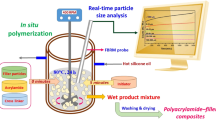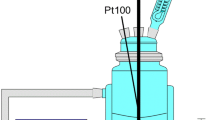Abstract
Nanocomposites with polypropylene as matrix material and nanoclay as filler were produced in a double twin screw extruder. The extrusion was monitored with a spectrometer in the visible and near-infrared spectral region with a diode array spectrometer. Two probes were installed at the end at the extruder die and the transmission spectra were measured during the extrusion. After measuring the transmission spectra and converting into turbidity units, the particle distribution density was calculated via numerical linear equation system. The distribution density function shows either a bimodal or mono modal shape in dependence of the processing parameters like screw speed, dosage, and concentration of the nanoclays. The method was verified with SEM measurements which yield comparable results. The method is suitable for industrial in-line processing monitoring of particle radii and dispersion process, respectively.













Similar content being viewed by others
References
Jordan J, Jacob KI, Tannenbaum R, Sharaf MA, Jasiuk I. Experimental trends in polymer nanocomposites—a review. Mater Sci Eng, A. 2005;393(1-2):1–11.
Paul DR, Robeson LM. Polymer nanotechnology. Nanocomposites Polymer. 2008;49(15):3187–204.
Schönfeld S, Nanocomposites. Special; 2003:28–33.s
Apfel U A. Turbidity study of particles interaction in latex suspensions. Colloid Polym Sci. 1994; 272(7):820–9.
Rohe T, Becker W, Krey A, Nägele H, Kölle S, Eisenreich N. In-line monitoring of polymer extrusion processes by NIR spectroscopy. Near Infrared Spectrosc. 1998; 6:325–332.
Rohe T, Kölle S. Inline nahinfrarotspectroskopie bei der kunststoffextrusion. GIT Labor-Fachzeitschrift; 2000.
Becker W, Eisenrich N. Measurement of the Irganox content in polypropylene polymers during extrusion. J Near Infrared Spectrosc. 2005;13(1):147.
Rohe T, Kölle S, Stern C, Eisenreich N, Eyerer P. Inline near infrared(NIR) spectroscopy for application in polymer extrusion processes. Recent Res. Devel. Pure & Applied Anal. Chem. 2001; (3).
Furukawa T. On-line monitoring of melt extrusion transesterification of ethylene vinylacetate copolymers by near infrared spectroscopy and chemometrics. Journal of Near Infrared Spectroscopy. 2002; 195–202.
Kerker M, Loebl EM. The scattering of light and other electromagnetic radiation. Physical chemistry. A Series of Monographs. Burlington: Elsevier Science; 1969.
Berdahl P, Espinoza LH, Littlejohn D, Lucas D, Perry DL. Near-infrared turbidity of ß-FeOOH particle suspensions. Appl Spectrosc.2000;54(2).
Apfel U. Precise analysis of the turbidity spectra of a concentrated latex. Langmuir 1995; 11:3401−7.
Kohlgrüber K. Co-rotating twin-screw extruder. München: Carl Hanser Verlag GmbH & Company KG; 2012.
Nguyen QT, Baird DG. An improved technique for exfoliating and dispersing nanoclay particles into polymer matrices using supercritical carbon dioxide. Polymer. 2007;48(23):6923–33.
Wang Y, Chen F-B, Wu K-C. Twin-screw extrusion compounding of polypropylene/organoclay nanocomposites modified by maleated polypropylenes. J Appl Polym Sci. 2004;93(1):100–12.
Peltola P, Välipakka E, Vuorinen J, Syrjälä S, Hanhi K. Effect of rotational speed of twin screw extruder on the microstructure and rheological and mechanical properties of nanoclay-reinforced polypropylene nanocomposites. Polym Eng Sci. 2006;46(8):995–1000.
Kerker M. The scattering of light and other electromagnetic radiation. Physical chemistry, vol. 16. New York: Academic Press; 1969.
Bohren CF, Huffman DR. Absorption and scattering of light by small particles. Weinheim: Wiley-VCH; 2007.
Guschin V, Becker W, Eisenreich N, Bendfeld A. Determination of the nanoparticle size distribution in media by turbidimetric measurements. Chem Eng Technol. 2012;35(2):317–22.
Phillips DL. A technique for the numerical solution of certain integral equations of the first kind. J ACM. 1962;9(1):84–97.
Twomey S. Comparison of constrained linear inversion and an iterative nonlinear algorithm applied to the indirect estimation of particle size distributions. J Comput Phys. 1975;18(2):188–200.
Guschin V. Kombination von turbidimetrsichen Methodenmit Verfahren der multivariaten Datenanalyse zur Prozesscharakterisierung von Nanokompositen. doctor thesis Fakultät für Maschinenbau Karlsruher Institut für Technologie (KIT). 2016.
Workman J, Weyer L. Practical guide and spectral atlas for interpretive near-infrared spectroscopy. 2nd ed. Boca Raton, FL: CRC Press; 2012.
Alig I, Steinhoff B, Lellinger D. Monitoring of polymer melt processing. Meas Sci Technol. 2010;21(6):62001.
Polyanskiy MN (2016) Refractive index database, http://refractiveindex.info
Yovcheva T. Refractive index of corona-treated polypropylene films. J Optic Pure Appl Optic. 2008; 10:5.
Kortüm G. Reflexionsspektroskopie. Grundlagen, Methodik, Anwendungen. Berlin, Heidelberg: Springer; 1969.
Steele HM, Turco RP. Retrieval of aerosol size distributions from satellite extinction spectra using constrained linear inversion. J Geophys Res. 1997;102(D14):16737–47.
Kessler W. Multivariate Datenanalyse für die Pharma-Bio- und Prozessanalytik. Ein Lehrbuch. Weinheim: Wiley-VCH; 2006.
Kessler RW (ed) Prozessanalytik. Strategien und Fallbeispiele aus der industriellen Praxis. Weinheim: Wiley-VCH; 2006.
Author information
Authors and Affiliations
Corresponding author
Ethics declarations
Conflict of interest
The authors declare that they have no conflict of interest.
Additional information
Published in the topical collection Process Analytics in Science and Industry with guest editor Rudolf W. Kessler.
Electronic supplementary material
Below is the link to the electronic supplementary material.
ESM 1
(PDF 1328 kb)
Rights and permissions
About this article
Cite this article
Becker, W., Guschin, V., Mikonsaari, I. et al. Turbidimetric method for the determination of particle sizes in polypropylene/clay-composites during extrusion. Anal Bioanal Chem 409, 741–751 (2017). https://doi.org/10.1007/s00216-016-0038-3
Received:
Revised:
Accepted:
Published:
Issue Date:
DOI: https://doi.org/10.1007/s00216-016-0038-3




